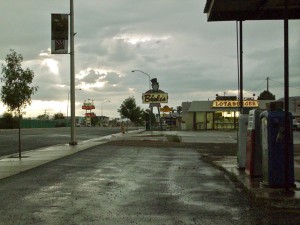There are places in Silicon Valley where you can stand along the edge of San Francisco Bay and look back at the Coastal Range, and during the summer you can watch as the fog from the Pacific Ocean spills over the low points in the ridge line. On the other side of the Coastal Range, an ocean current hits the shore line, and deep cold water comes to the surface where it meets warmer air, and condenses into fog. The fog will build up until it’s five hundred or a thousand feet high, high enough to spill over the low points in the ridge. You can watch the fog working its way down through the distant woodlands some miles away and hundreds of feet higher than where you stand, down at sea level, in the warm bright sunshine of Silicon Valley.
Category Archives: Sense of place
Roadtrip: Needles to El Cajon, California
I left Needles, that “miserable place,” early in the morning. It was hot already. I drove south on U.S. 95, through the hot, dry, bleak Colorado desert. This is a two-lane paved road that I would not want to drive during a rain storm; there are no culverts (not that I saw, anyway) and the road dips down to meet every dry wash.
Bleak as it was, the desert scenery was spectacular: stark, forbidding mountains rising up out of the sand plains studded with creosote bushes. After more than an hour of driving, I began to pass side streets, and I began to see small houses here and there in the desert. A sign told me when I reached the city limits of Twentynine Palms, population nearly thirty thousand.
I stopped at the visitor’s center for Joshua Tree National Park, and walked around the Oasis of Mara. It was disappointing: no open water (the water table subsided some years ago after seismic action in the nearby Pinto Mountains), and fewer than twenty nine palm trees. But there were Gambrel’s Quail hiding under the low mesquites, and a pair of Prairie Falcons perched in one of the palms.
From Twentynine Palms, I headed south through the park. The Joshua Trees that give the park its name made me smile. They almost look as if they might start talking to you.
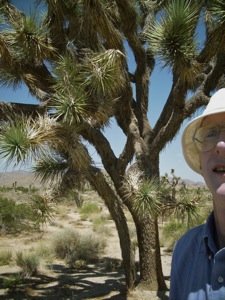
The cholla cactus seem to have personalities, too. Even though you know the lightest touch would be enormously painful, they look almost as if they wanted you to cuddle them.
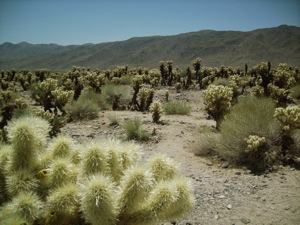
The tall, twisted octillo with its tiny leaves, the mesquite trees, the fan palms: all these amazing plants growing in a very unpromising environment. The birds are amazing too. I stopped at Cottonwood Springs, and even though it was the hottest part of the day, the birds were cheerful because of the seeping water. But the sun was too hot for me; I wanted to stay longer, but I was getting a heat headache, and drove on.
The rest of the drive merely took me deeper and deeper in the urban and suburban sprawl that stretches along the Pacific rim of California. I’m not really ready to stop, but here I am in El Cajon, just outside of San Diego, at the end of my 3,200 mile journey.
Roadtrip: New Mexico, Arizona, and California
This morning I took a side trip to El Malpais National Monument, which lies just to the south of Grants, New Mexico. I didn’t really go to see the lava flows which give El Malpais (“the badlands”) its name; I went to walk in the high desert, take some photographs, and maybe see some birds. I managed to do all three. You’ll have to take my word for the walking, but here’s a photograph of the lava flows (they’re the dark areas down in the valley), as seen from the top of Sandstone Bluffs:
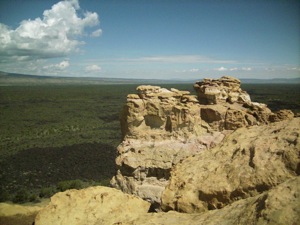
And I saw some birds, too: Black-Chinned Hummingbirds, Scott’s Orioles, Pinyon Jays, Cassin’s Kingbirds, and several other desert-dwelling birds that I had never seen before.
While I sat at the ranger station admiring the hummingbirds and orioles coming to the hummingbird feeder, I heard thunder in the distance. Not long after I started driving, it started raining. I drove through rain from Grants to Gallup. I stopped in Gallup to get lunch and gas, and while I was eating lunch there was a real downpour. I ran out to the car when the rain let up a little, and drove through streets that were several inches deep in muddy brown water. This is insane, I thought, but I was on a tight schedule, so I got on the freeway and drove slowly through the rain. Pretty soon it let up, but I drove through occasional light showers for most of the rest of the day.
I decided I didn’t want to spend any money in Arizona, because of the ridiculous immigration law that the state legislature passed. While I’m sure Arizona will never notice the loss of my paltry travel dollars, I felt better knowing that I had not bought any gas or food in the state. Unfortunately, Arizona is in such tough financial shape that they have closed all the highway rest areas, so somewhere around Flagstaff where there are trees, I found a place by the side of the road where I could pee.
I arrived in Needles, California, at about 7:30. When I opened the door of the car, the air was unbelievably hot. It was so hot and dry that my eyeballs kind of hurt; and every once in a while, a gust of hot wind coming off the desert would make it feel even hotter. According to the National Weather Service, at 6:56 p.m. it was 105 degrees; and last night, the low temperature was 90 degrees.
In spite of the heat, I walked the few blocks from the motel to downtown Needles. The air was so dry, I could feel the moisture being sucked out of my mouth and nose. Not much was happening in downtown Needles; the main activity seemed to be around the BNSF (Burlington Northern Santa Fe) railroad yards, where dozens of cars and pickup trucks were parked. A few people were out walking around, a few cars passed by, but mostly the town was empty. The cartoonist Charles Schulz, who drew the “Peanuts” cartoon, lived here for a few years when he was a child, and his biographer David Michaelis writes:
By day, the sun broiled the vast playa above the town — 120 degrees in the shade of a cottonwood tree was normal for Needles in summer. Most winter nights, the translucent air turned the dry gullies into such iceboxes that he [Schulz] could hear rocks cracking in the cold. In May and September the old wooden tinderbox of a schoolhouse was frequently shut to protect the children from heatstroke. Such little rain as fell came briefly and violently, blasting flash floods out of nowhere.
Needles, [Schulz] decided, was a “miserable place.”
I bought a copy of the Needles Desert Star, “Established in 1888, serving the community of Needles for more than a century.” I learned that the city attorney has been holding training sessions on Robert’s Rules of Order for the members of the city council and various boards; this seems a good plan, and I can think of several communities that should try this sort of thing. Tribal elders gave blessings in the Mohave language to a new park project being built with America Recovery and Reinvestment Act money. And city council members held a meeting to address the sale of the local hospital. In 1983, Charles Schulz’s “Peanuts” was syndicated in its two thousandth newspaper, in Needles, California (Michaelis, p. 531), but I did not find any comic strips at all today’s edition of the Needles Desert Star.
Roadtrip: Oklahoma, Texas, and New Mexico
Soon after I left Elk City, Oklahoma, I saw my first sagebrush by the side of the highway. Agricultural fields increasingly gave way to grazing lands. I’m now in the West.
For the past three days, I’ve eaten at an all-you-can-eat Chinese buffet each night for dinner. Each of these buffets featured some kind of melding of Chinese and American cuisine. The large buffet in Elk City featured french fries, “fried green beans” (a sort of tempura), and “hot buttered potatoes,” alongside the stir-fried vegetables and the fried spring rolls. Here in Grants, New Mexico, at the “Asian Buffet,” I could have had “jalapeno chicken (spicy)” had I wished. None of these buffets offered any kind of tofu dish.
The best meal in roadside restaurants in the middle of America is always breakfast. This morning, I ate at the Elk City Cafe. The waitresses wore t-shirts, jeans, and heavy make-up, and called me “sweetheart” — waitresses have called me “hon” before, but being called “sweetheart” was new to me. The over-easy eggs were perfectly cooked, the bacon was think and tasty, the oatmeal was not watery as it had been in Connecticut nor chunky as it had been in Pennsylvania but exactly the right consistency. The home fries were a little too greasy, but the toast was warm and buttery.
I wanted to take a long walk, to work off some of the grease I’ve eaten today, but it started raining during dinner — with thunder and flashes of lightning — and hasn’t really let up since, and now it’s getting dark. Instead of walking, I drove down the historic route of the famous Route 66 in Grants and looked at the strip:
Grants, New Mexico, looking from an abandoned gas station towards Lotaburger, during a rain storm.
Roadtrip: Missouri and Oklahoma
It was hot and humid yesterday when I arrived in Marshfield, Missouri. I went to bed early so I could get up early when it was cool enough to take a long walk.
I was out the door of the bed and breakfast at a quarter to seven. It was already in the high seventies, and the dew point couldn’t have been much lower than that. I walked up Clay street, across the one line railroad over which I’d seen three BNSF locomotives pull a mixed freight last night, up a block to the courthouse square. The Webster County courthouse, a gray Depression-era Art Deco building, is undistinguished. The courthouse square is neither pretty nor bustling; there are no trees to speak of; empty store fronts alternate with offices for lawyers and bail bondsmen, a small restaurant promising “Chinese Fast Food,” the Webster County Historical Society, and one attractive little grocery store in a far corner. It is far from the tourist stereotype of a Southern courthouse square.
I kept walking, and in another block I was on a tree-lined street. There was one big Victorian house, beautifully renovated and brightly painted, and then lots of small anonymous houses on big lots. I walked around the Webster County Fairgrounds. A damp sign lying in the grass told me that the county fair took place July 14-17; and a few pieces of carnival equipment were still parked on the fairgrounds. That was the only cheerful thing I saw on my walk, and it was really melancholy, for the fair was over for another year. Maybe it was just the heat, but I found the atmosphere of the town oppressive. I walked back to the courthouse square, and then, with some relief, walked back into the green and well-kept grounds of the bed and breakfast.
Today’s drive took me out of the rolling hills of southern Missouri into the flatness of western Oklahoma. I’m staying in Elk City tonight, and after dinner I walked around the center of the town. Downtown Elk City has no old buildings — it was founded in 1901 — and it is fairly flat and treeless. But it is an attractive town, with wide streets and the open feeling of the West. There is a pretty little Carnegie Library, and a couple of century-old brick buildings that are well-maintained. I got the impression of a lively mix of businesses: lawyers and accountants, a department store, several clothing stores, a boutique, a hair salon, the Elk City Cafe, buildings for two newspapers (looking at their buildings, I’d guess that the Elk City Daily News is considered more respectable than the Elk Citian), a large and bland but not unattractive post office, a small pharmacy and a big chain pharmacy, a hospice, a sewing machine and vacuum repair shop, a dollar store and a thrift store, a couple of medical supply stores, and various storefronts that had to do with farming and the oil business. One business had something to do with the oil business (the name was something-or-other oilrigging), and a sign on the door proclaimed, “Please take off work boots before entering office.”
Most everything was closed by the time I got there. It was still very hot, but I kept walking around the downtown, impressed by the sheer variety of the businesses. This was a downtown that had not yet been killed off by the malls; I’ll bet you can buy everything from hardwear to underwear to a ten gallon hat, and sell your oil well to boot. On my way back to the motel, I took some back roads. While there aren’t many trees, the countryside around Elk City is green and rolling, and pleasant to look at. It felt like a place that might be nice to live in.
Roadtrip: Indiana, Illinois, Missouri
Two photographs from today’s drive:
(1) Bus parked in gravel lot next to the Motel 6 Parking lot, Cloverdale, Indiana, 19 July 2010 at approximately 9 a.m.:
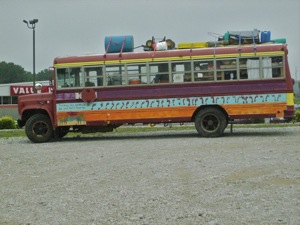
The text on the side of the bus reads: “Feeding the world so you don’t have to.” The designs on the light blue stripe on the side of the bus are footprints; above that in the purple strip are handprints. I could not make out what kind of equipment was tied to the roof of the bus; perhaps it was gardening equipment. Through the windows of the bus, I could see additional equipment. Unfortunately, there was no one around the bus whom I could ask.
(2) Signs at the junction of Interstate 44 and Missouri Route UU:
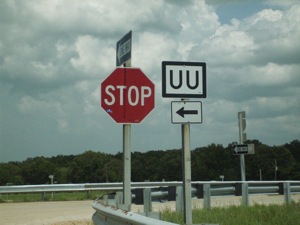
Roadtrip: Pennsylvania, Ohio, Indiana
I took three short trips off the interstate today, trying to find something other than rest areas and the usual fast food joints you find near interstates. The first two side trips were unsuccessful. The first led to malls and suburbia, and the second led to a place that wasn’t worth the trip.
But the third side trip led to the barn where my older sister is taking care of three horses. It led me past the Village Smorgasbord in the middle block of downtown Hagerstown. It wound down past a small creek bed, through woodlands, around a bend where a white clapboard church, Nettle Creek Friends Meeting, stands next to a little cemetery, then in between eight foot high walls of corn, and at last to a house where my sister fed me dinner, and then to the barn where her horse is stabled.
Jean and I and the two dogs, Tracer and Parker, walked from the house down to the barn. Already in the barn were several pairs of barn swallows, three horses, and a cat named Pumpkin who ate baby Barn Swallows when he could get them. Jean showed me how the timbers of the barn had been hand hewn, and pegged together with oak pegs. Tracer lay down on the barn floor and kept an eye on things:
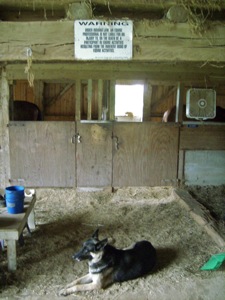
All too soon, it was time for me to get on the road again, and I forgot to wish my sister a happy birthday. Happy birthday, Jean!
Roadtrip: Connecticut, New York, Pennsylvania
The price of the motel included a full breakfast. I brought yesterday’s New York Times to read. A man with glasses and carefully combed silver hair sat at a nearby table. He was wearing a dark polo shirt and neatly pressed white shorts. He eyed my paper. “You got that at the front desk?” he said. There was just a hint of a sharp tone in his voice; he was in obvious newspaper withdrawal. “No, I got it from my car,” I said. His face fell. The only newspaper available at the motel was USA Today.
As I drove over the high point of the Taconic Hills, over the border from Connecticut into New York, a sign gave the elevation as 970 feet. Near the Pennsylvania border, we reached a high point of about 1250 feet. Then halfway across Pennsylvania, a sign told me that I had reached the highest point on Interstate 80 between the Atlantic Ocean and the Mississippi River, at about 2250 feet. Some of the scenery was spectacular, the road winding in among wooded hills and mountains that had clearly been shaped by glaciation. In many places, the road had to be cut through bedrock:
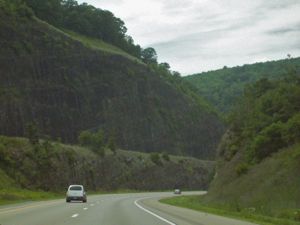
In the middle of the afternoon, I started getting fatigued. I had gone through several road construction projects where the road went to one lane, and at one point traffic had come to a complete stop due to an accident; when I passed the accident scene, they were trying to right an overturned car. I pulled into a rest area. Down behind the picnic area, a small stream wound through some woods. I walked along looking at the plants: big eastern hemlocks with young beeches pushing up around them, sassafras in the understory, and on the forest floor wintergreen, ground pine, jewel weed, trillium, all the familiar plants of the eastern woodlands. I picked a wintergreen leaf and smelled it. This would be the last of the eastern woodlands that I’ll see this year.
Towards evening, I decided to pull off the road to see if I could find a place to eat. I chose Reynoldsville, because I liked the look of countryside. It was seven miles away from the interstate, along a two-lane highway that was straight at first, then began to wind down an increasingly steep hillside, until suddenly I was on the main street of Reynoldsville. I parked the car and went for a walk. There were three or four restaurants, but they all seemed to feature pizza, except for one restaurant which promised “home cooking.” A woman was getting into her car in front of the Episcopal church. “Going for a walk?” she called out to me. “Yup, stretching my legs,” I said and smiled. Several of the houses had anti-abotion signs on their small front lawns: “Abortion stops a beating heart”; “Respect Life”; “Choose Life.” Reynoldsville did not seem like the kind of place where a middle-aged man with a pony tail would exactly fit in. I got in my car and drove back to the interstate.
Next I tried Brookville, because of a sign which mentioned the “Brookville Historic District.” When I got to Brookville, there were some impressive houses, most of which were carefully maintained. Right across from the big red courthouse with the brillian white trim, there was a little restaurant called “The Courthouse.” I would have been the youngest person there by a good twenty years. I decided that as pretty as the town was, I would not try to eat dinner there. I walked around a little bit, and came across a small manufacturing plant with a sign that said “Brookville Locomotive / Diesel Locomotives / Personnel Carriers.” This could not have been their main plant, though, for there were no railroad tracks anywhere nearby.
Roadtrip: Maine, New Hampshire, Massachusetts, Connecticut
Hot and humid at midafternoon, with a sky that threatened thunderstorms later. I drove out of the Ferry Beach Conference Center campground and headed towards Biddeford and Interstate 95. Slow going through Saco and Biddeford, moderately heavy traffic on the interstate. After I turned on to 495, I could see that the northbound side had very heavy traffic, which came to an almost complete stop at the approaches to 95 north, 93 north, and 3 north; presumably vacationers heading north. It was hazy, hot, and humid, and the thick hot air made distant hills look bluish. I made a quick stop in Stow to eat dinner with Carol and her dad, and then got back on the road. Lots of traffic through Worcester, then a little less through the eastern hills of Connecticut, then more traffic around Hartford, along with heavy rain and lightning. The rain ended leaving a faintly pink sky in the dying light, then light traffic through the steep hills of western Connecticut. A maddening construction delay, then at last I made it to the motel feeling frazzled. This morning I was awakened in my tent by the sound of a Wood Thrush singing.

